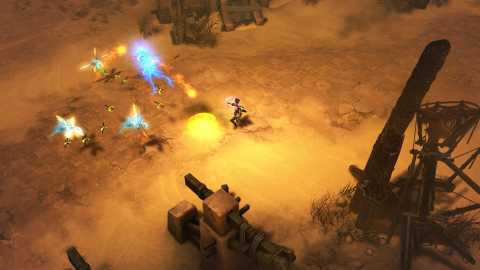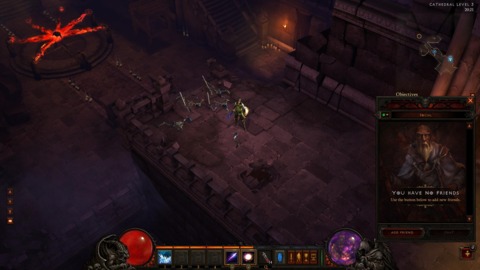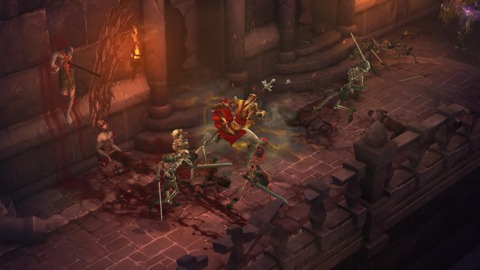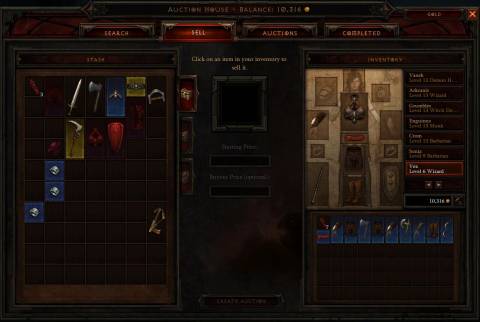
Blizzard made no attempt to reinvent the wheel a couple of years ago when it revitalized StarCraft after its decade-long absence, choosing instead to simply modernize and spit-polish that franchise's well-known fundamentals until they reached the company's trademark high-gloss sheen. They've taken the same tack in reviving Diablo after its own 12-year hiatus, and once again the result hews to the nostalgic strengths of its antique predecessors while also managing to feel like it belongs on a release list in 2012. And it's a hell of a lot of fun to play, with hooks that keep you playing longer in one sitting than you might have wanted to. I'm not the type to often play through a game more than once, so I guess it's saying something that after more than 35 hours with the game--first playing all the way through with my primary character, then playing through a bunch of it again on the next difficulty, jumping into numerous dungeon runs with friends, and dabbling with several other classes (all of whom I'd love, time permitting, to take to high levels themselves)--I really just want to keep playing more Diablo III.
This new game's staunch adherence to its loot-driven action-RPG conventions might tell you right off the bat if you should even be interested or not. Do you like loot? Not just a little bit of loot, but ubiquitous, shiny, delicious, stat-increasing loot everywhere you look? Just like its predecessors--and perhaps even more so than them--Diablo III is a game about constantly building and rebuilding your character with new gear and abilities to meet the challenges that are constantly increasing in front of you. It's also a game where the extent of your interaction with the world entails clicking to move, and clicking and tapping some number keys to kill everything in front of you. You play it entirely from a fixed overhead camera angle, and the story, aside from a handful of lavish CG cutscenes, plays out exclusively through small character models gesticulating a bit while their dialogue comes out of speech bubbles. In short, it rigidly assumes the form and structure of the old Diablo games, so if you already know you're burned out on that specific formula, you may move along.

If that sort of game does it for you--and there are plenty of you out there--you'd have a tough time finding one that's better put-together than Diablo III. A game where you spend 98 percent of your time killing stuff (and the remaining time performing upkeep on your ability to kill stuff) would get old pretty fast if the combat weren't a ton of fun, so it's a good thing Diablo III's is. I think it's the hardest-hitting I've ever seen in the genre. There's something about the interactions between your fighter and enemies, the visual and sound cues that go along with every strike, that just makes the combat feel, for lack of a better word, right. So often you feel like an unstoppable whirlwind of destruction when you wade into a dozen or more enemies and juggle your skills back and forth to control the crowd, focus down a single tough elite monster, or kite a bunch of enemies around as you frantically try to heal. The action is just tightly designed in a way that seems like a lot of designers spent a lot of time tuning it to perfection. Fighting enemies in this game never gets old, which is a good thing since finishing the story once sends you straight back to the menu with an urging to begin again on the next difficulty, where the loot is much better and the enemies don't just hit harder but also change up their tactics, forcing you to change up yours. I can't stress enough how enjoyable it is to keep playing after you see the credits the first time.
The game's classes cover all the bases you'd want, from the pure burly melee of the barbarian to nimble and arcane DPS courtesy of the demon hunter and wizard, respectively, to the horde of sinister pets that accompany the witch doctor into battle. My personal favorite, the monk, is like a martial paladin who can effectively heal up in between roundhouse kicks and a blur of fist strikes. Each class' skills are split across a variety of categories, and almost every skill has a long list of "runes" you pick from to add some ancillary effect that further differentiates them. The breakdown of skills into those different categories initially seems constraining, but there's actually a dizzying number of ways to build the skills of a given class to fit different play styles and challenges. Why the game hides the full ability to mix and match your skills behind the optional "elective mode" checkbox in the options, however, is completely baffling to me. Elective mode is absolutely essential to getting the most out of the game's combat, so it's a shame there isn't some tutorial tip that goes out of its way to let you know how much freedom to customize you actually have. Once you click that single checkbox, the gameplay really opens up.

If this were purely a combat game, I guess it could be conducted with stick figures and primary colors, but of course it's worth addressing the world and story Blizzard built up to propel your loot grind along. The plot proceeds with equal parts gravitas and cheese, about like you'd expect from a story about a literal war between heaven and hell, but that setup does make for some truly epic, screen-filling boss encounters and sieges for you to fight your way through. It's also fun to revisit some memorable old locations like Tristram (which comes with just a hint of the discordant acoustic guitar that practically defined that first game) and catch up on the continuing events of familiar characters like Deckard Cain and the skeleton king Leoric. Much more impressive is the expertly considered art design that bathes the game in exquisite detail and makes excellent use of color choice and lighting to create unique mood specific to each location. Don't think that the tiny character models and bird's-eye view of the action somehow make this game outdated from a visual standpoint. The art is so strong that each scene takes on a painterly effect that almost transcends its polygonal makeup, and I kept noticing how much detail was crammed into the periphery of each map, like a collapsed bridge here or some old statuary there, in places you can't even explore. There's a liberal use of ambient animations, like birds flying at the camera or old architecture crumbling when you run by, that make the environments feel more lively, and the game's excellent use of ragdoll to send enemies flying over ledges or into the water is always amusing.
But again, it's about the loot, and how much fun the fighting is that gets you more of it. The game changes dramatically when you join up with other players, since the monsters get harder and you're able to settle into a more specialized role while other classes cover their own roles, allowing you to change up the way you play and what combination of skills you're using. The game isn't incredibly difficult your first time through, but I found it doled out new equipment and better drops at a good, steady pace as I got a handle on all the things my class could do, so that by the time the next difficulty rolled around, I was jumping at the chance to get in there with some friends and explore a range of new combat possibilities under much greater duress. It's when three or four high-level players are all in there doing their thing at once, with the action devolving into a high-speed orgy of colored lights and particle effects, that Diablo III is at its best. The game makes the elegant choice of distributing separate loot to each player, so you don't have to worry about some jerk grabbing the spaulders or daibo you wanted, but so far I've found there to be a nice spirit of sharing among all the players I've played with as we pass loot around that suits other people's classes.

It's too early to say what eventual impact the game's persistent auction house will have on Diablo III's economy and the value of rare items, especially since Blizzard hasn't rolled out the ability to sell stuff for actual dollars yet. It's safe to say that launch will have a profound effect on the way items are bought and sold, but even now the transactions being conducted with gold are providing an interesting case study in the ebb and flow of in-game economics. It's been amusing to see comparable items being listed right next to each other with an order of magnitude disparity in their pricing, leading me to believe some players are listing items as high as they can to see what they can get away with, or others are trying to sell gear without knowing the value of what they actually have, or both. Who can even say what the absolute value is of a one-handed sword with 100 damage per second and a bonus to attack speed? More practically, the game's auction house gives you so much control over search filtering that it's almost embarrassingly easy to specify the exact type of weapon or armor you're looking for, the level range, the stats you want, and exactly how much you're willing to pay for it. At the moment, there are enough people selling great loot at bargain-basement prices that too much time in the auction house can sort of trivialize the gear you find in the game itself. Whether that's a problem for you probably comes down to personal preference, and given that the auction house exists only at the game's main menu, it's easy enough to ignore if you want to maintain some sort of loot-lust purity as you make your way through. If you don't have a ton of time to grind through dungeon runs in an endless search for more loot, though, it can be a real time-saver.
Speaking of multiplayer and that auction house, you could scarcely know about Diablo III at all without having heard about the game's always-online connectivity that requires you to be constantly in touch with Blizzard's servers to play it at all, even by yourself. That approach to maintaining the sanctity of the in-game economy (and making sure a bunch of people don't hack and/or pirate the game) comes with plenty of ups and downs. On the upside, the level of integrated connectedness is pretty impressive, letting you chat with friends while you're playing alone, seamlessly invite them into your game or join theirs whenever you feel like it, and even inspect their characters and see their achievements popping up in real time. On the downside...if you can't connect to Battle.net, you can't play the game, no matter whether you want to play it with other people or not. That has real, unfortunate consequences when Blizzard doesn't have its act together, as evidenced by the calamity that ensued in the first 36 hours of release when I frequently had a hard time getting into the game at all, and latency-related issues messed with performance and booted me out a couple of times. It's been smooth sailing in the week since then, though, and given Blizzard's experience running large online networks for long periods of time, I'm hopeful those problems were an isolated incident under massive launch-day stress and not something we can expect to see again.
I can't stay mad at Diablo III for long, anyway. It's such a rare thing that my interest in continuing to play a game keeps increasing not just toward the end of the game but past the end, yet somehow the more Diablo I play, the more Diablo I want to play. It doesn't do anything especially new with the action-RPG genre, but it does all the old things very, very well, and sometimes that's more than enough.